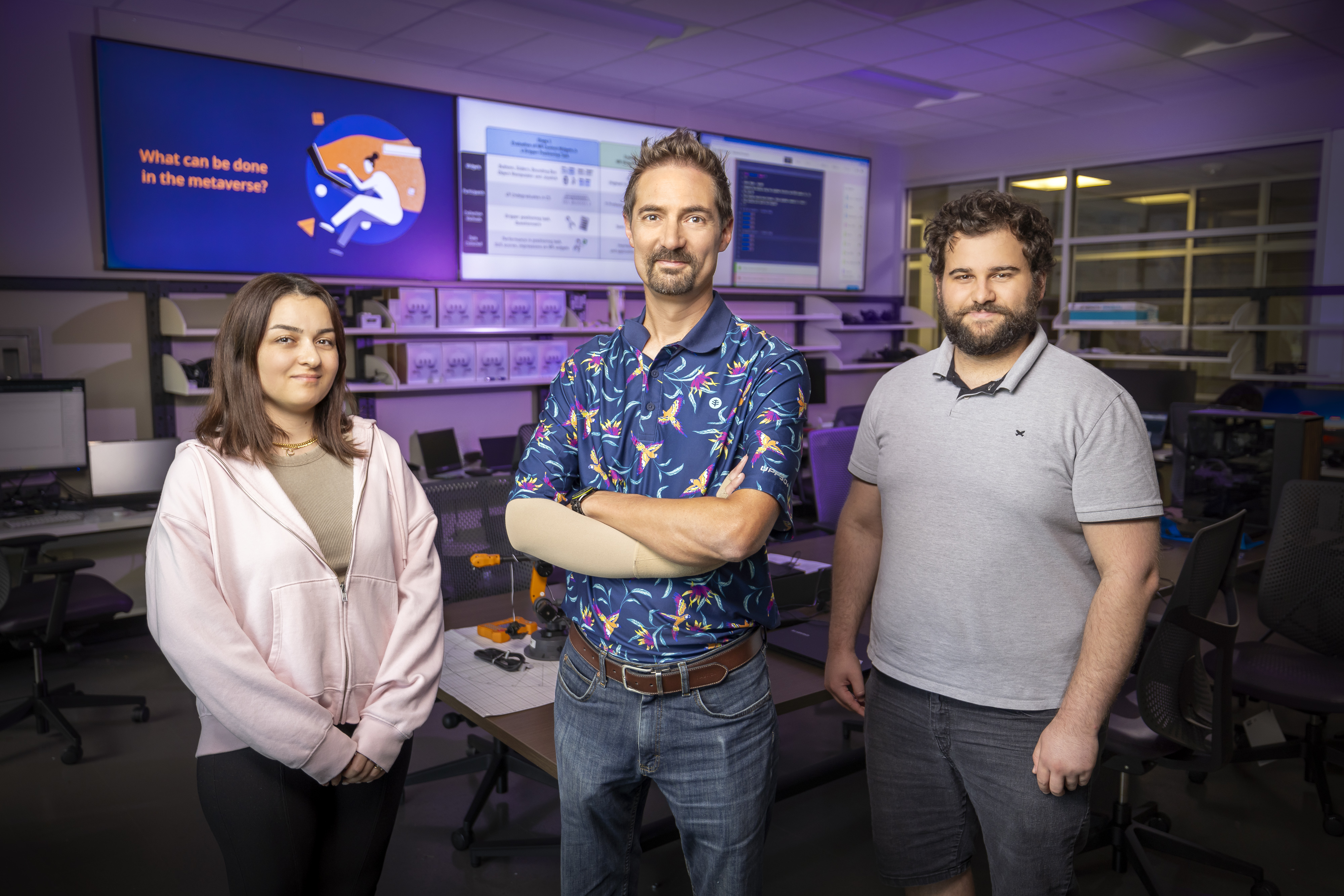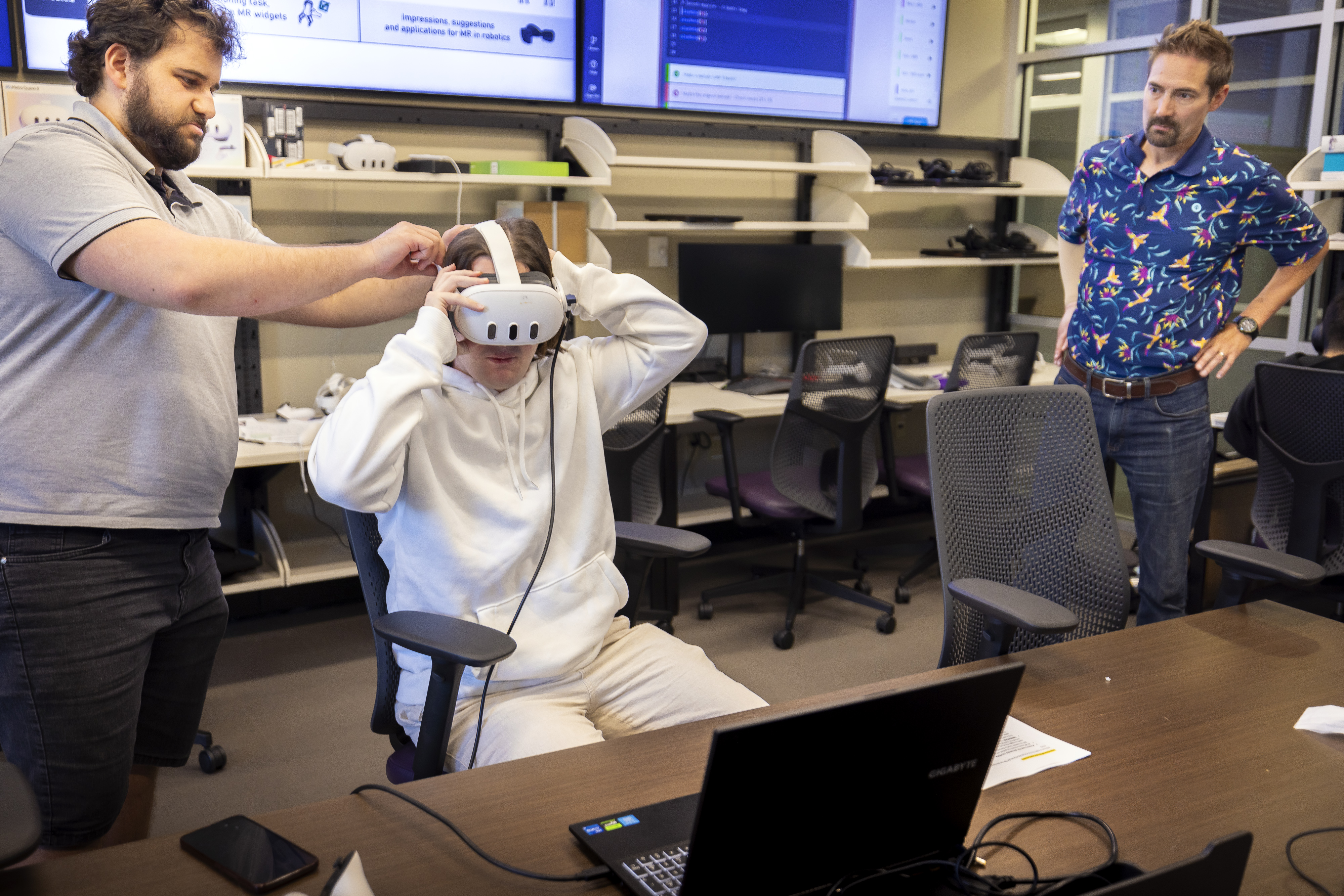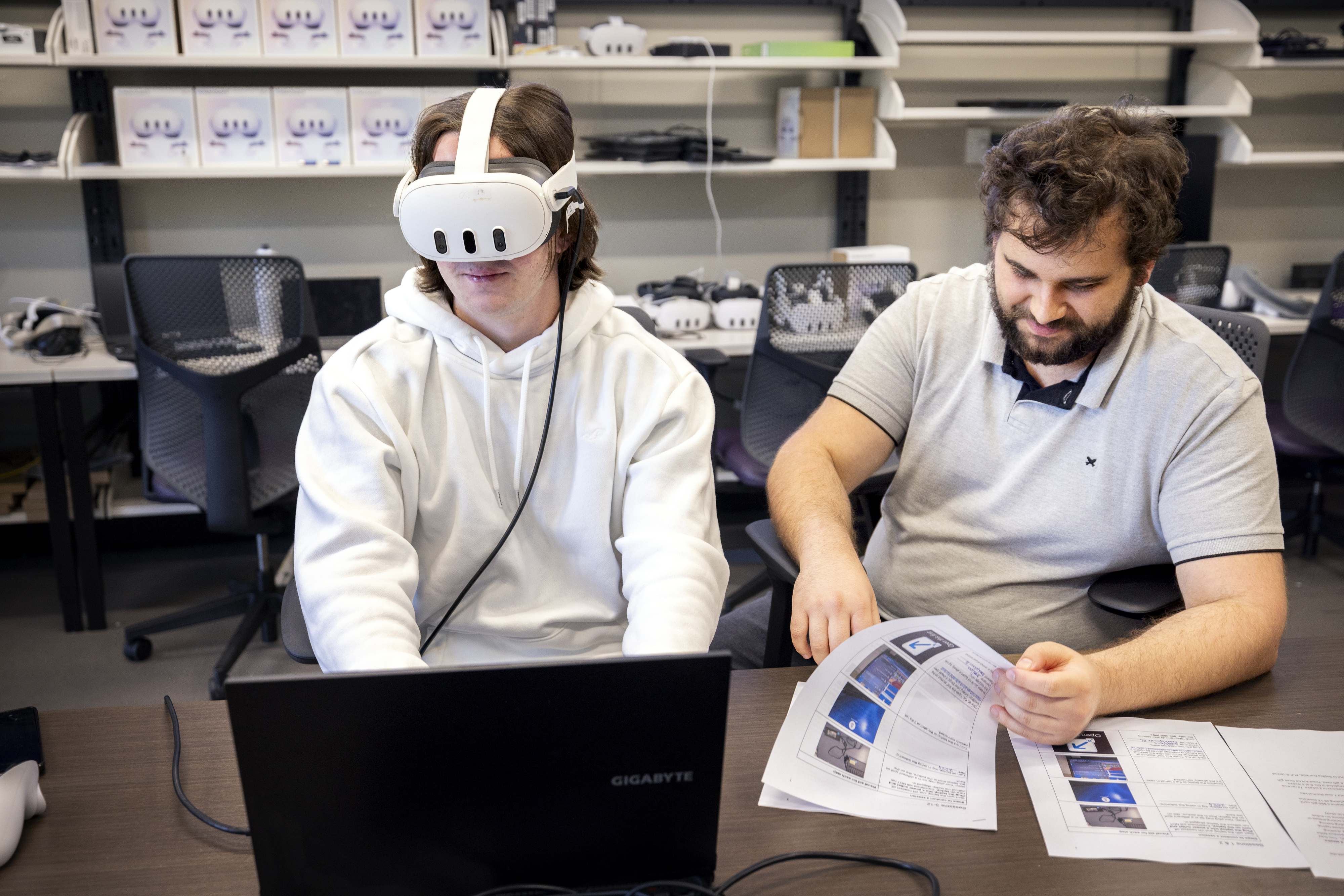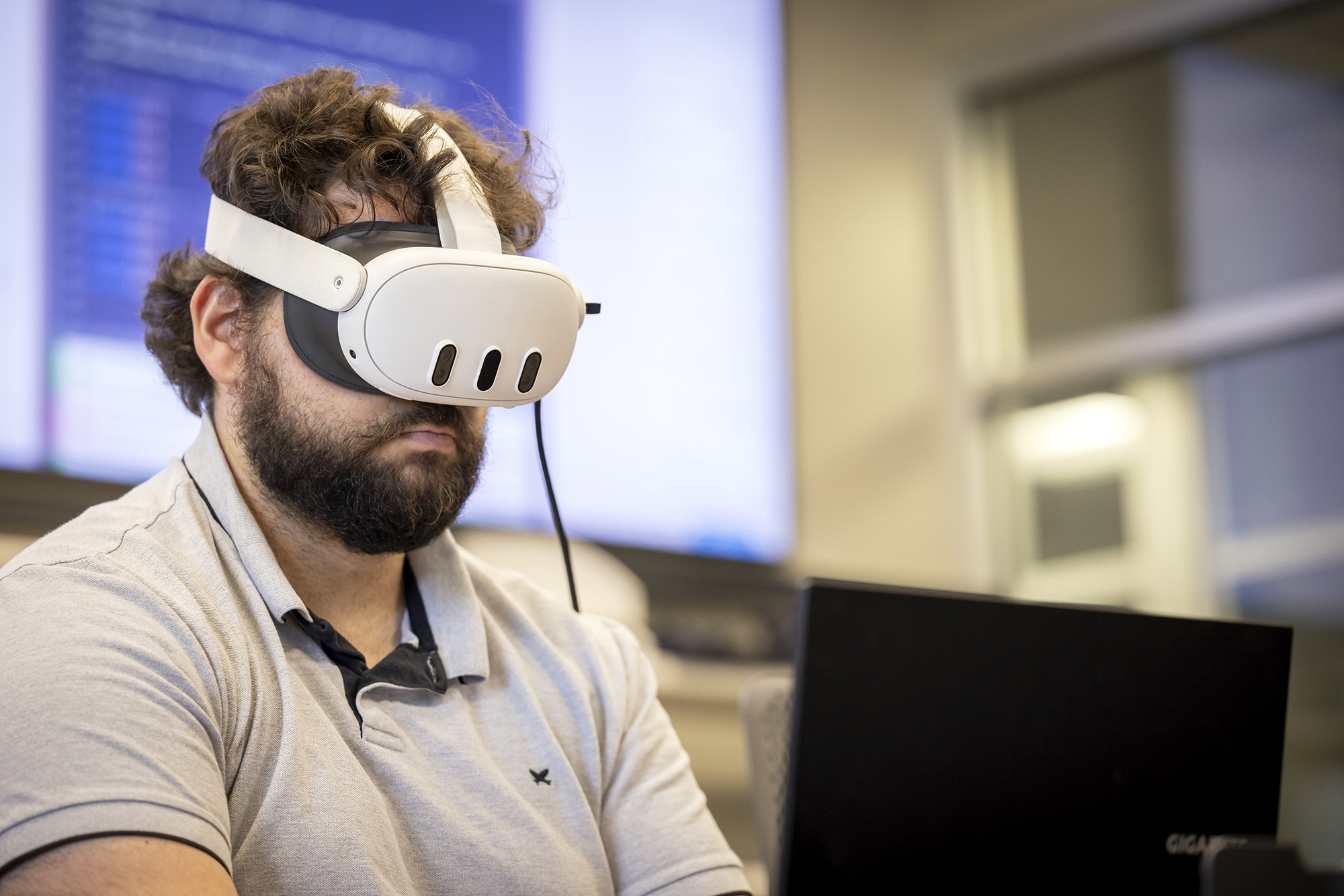The Future of ADHD Treatment? LSU’s VR Research Aims to Help Students Focus and Succeed
October 29, 2024
Thousands of children in Louisiana struggle with attention-deficit/hyperactivity disorder, or ADHD, which can interfere with their schoolwork and daily lives. Louisiana ranks among the states with the highest number of ADHD diagnoses. For many families, treatment can be expensive, frustrating, and overwhelming for their parents.
But LSU Associate Professor of Computer Science David Shepherd’s research may just revolutionize ADHD treatment by using virtual reality, or VR, and noise-canceling headphones to block out distractions and help these children focus.
Shepherd’s team created an immersive, distraction-free environment to help students stay focused. Partnering with ADHD expert Josh Langberg and funded by the National Institute of Mental Health, or NIMH, this groundbreaking project could offer a transformative, non-medication-based solution for children with ADHD.

Associate professor of computer science David Shepherd with Ph.D. students Fatemeh Jamalinabijan, left, and Matheus Costa.

Matheus Costa helps a student adjust a headset.

A student uses a VR headset while working on a computer with Matheus Costa.

Ph.D. student Matheus Costa uses a VR headset during testing.
What specific challenges do children with ADHD face that this technology aims to address?
Children with ADHD are more likely to be distracted by external stimuli and more likely to get lost in their own thoughts. Our hardware setup blocks external stimuli, and our software nudges students back on track when they become idle or distracted by non-work apps and websites.
How do the noise-canceling headphones and VR glasses work?
The headphones block out all but the loudest external noises, and the VR glasses show a virtual bedroom specifically designed to create focus. The Quest 3, our VR headset, has good enough resolution that students can easily read text. This is obviously necessary for completing homework in VR, but until the most recent generation of headsets, the resolution was so low that words had to be the equivalent of inches tall to be read.
Explore the LSU Division of Computer Science and Engineering
How does combining VR and noise-canceling headphones improve focus and attention in students with ADHD?
Imagine this: you are in a noisy dorm room or classroom. You turn on your laptop and put on your VR glasses and noise-canceling headphones. Suddenly, you’re in a quiet bedroom with a view of your laptop screen, a view of your laptop keyboard, and no external distractions. Your friends may still be throwing the football down the dorm hallway or gossiping about the latest news, but to you, they are miles away.
As you start to work, you notice a large stoplight at the bottom left of your screen. It is green, which makes you feel good. You start working on homework, but then remember to plan your spring break trip. As you view options on Travelocity, the stoplight quickly turns red and begins beeping, like a fire alarm with a low battery. Realizing you are off track, you return to your homework and finish in time to head to the food court with your friends.
What do you hope the future holds for this research, and how do you envision it impacting ADHD treatment on a larger scale?
Our goal is to impact thousands, if not hundreds of thousands of the next generation of students. While our current solution works in conjunction with a laptop, we plan to streamline it to work directly on the VR headset. That would open it up to any student who owned a VR headset, of which there are hundreds of thousands.
How does this non-medication approach compare to traditional ADHD treatments, and what are the key benefits of using this technology?
Stimulants are the primary medication used for ADHD, and they can be effective for some students, but there are risks, including personality changes. While other approaches, like constant monitoring and feedback from a tutor, are highly effective, most families do not have the resources for this solution. Our solution, which requires no medication, is like having a human monitor but is more cost-effective. Instead of paying someone by the hour for perpetuity, a one-time headset purchase is more convenient. And with Meta headsets scheduled to drop to $299, the costs of these headsets continue to plummet.
What was the inspiration behind your research?
Our lab had a VR headset, and I noticed students used it to block out the lab noise. So, we started a side project on using VR to help high-end knowledge workers remain focused. However, the project had little momentum.
One day, everything changed. We discussed the project’s progress and how we would test it out. One student spoke up, saying, “We should test it in dorm rooms and apartments. I have ADHD, and if I could block out my noisy roommates and keep on track, it would be a game changer.” We all immediately grasped that this was the project we SHOULD be doing: helping students with ADHD. Within a week, we collaborated with Josh Langberg, an expert in ADHD, and within a year, we were funded by NIMH.
“These students ... are remarkably focused during their VR sessions. I can’t help but get excited about this approach’s immediate impact on their lives.”
— David Shepherd,
LSU Associate Professor of Computer Science
How are LSU students involved in the research?
Last year, 25 students completed 10 VR sessions. We also had two full-time PhD students working on the project, from the overall solution to the screenshot analysis. This year, we will have about 45 students complete 12 VR sessions. About 10% will happen at Rutgers, where our collaborator works.
What reaction have you received from participants in the study?
Shepherd provided the following feedback from participants:
- P1: “The VR helmet is like my babysitter that helps me make sure I am doing it.”
- P4: “I would say I was able to use VR in a way I didn’t know was possible and to complete my assignments in a quicker and more efficient way. It helped me get things done.”
- P8: “Honestly, overall, I found myself very much looking forward to each time I got to go ... I wish there were more than the 12 sessions.”
- P13: “It was a good way for me to stay focused, and I completed a lot more work than I thought I would be able to in an hour while using the VR.”
What is next for the research?
This year, we will complete a larger study, about 45 students, specifically comparing typical laptop work to laptop work while using VR to laptop work that uses VR with feedback. This will give us a clear picture of how each component of the approach contributes to the student's overall success. If this study goes well and we see improvement over non-VR work, we will be eligible for the second part of our NIMH funding, which will involve running experiments with about 200 participants with ADHD!
What impact do you hope this research has on the world?
I want to help students, especially students from lower-class backgrounds, stay on track in school even though they cannot afford expensive tutoring. I want to ensure these students, who can grow up to make great contributions to the world, do not get left behind just because they got off track during their early years.
What has been the most rewarding aspect of this research for you?
I have recently been reviewing the detailed logs of students using our software. These students, who claimed to have ADHD, are remarkably focused during their VR sessions. I can’t help but get excited about this approach's immediate impact on their lives.
What other areas of research are you involved in?
I work on using music, specifically hip hop, to make learning computer programs more engaging. We write code that makes hip-hop beats! I also work on using AR to get students moving while they use computers… There’s no reason that energetic middle schoolers should be hunched over a Chromebook all day!
You’ve recently joined the LSU community. Why did you decide to come to LSU to continue your work?
I came to LSU because of the resources they are willing to dedicate to computer science. From the beautiful engineering building to the generous startup packages to the name brand, which helps recruit PhD students, LSU is a school that makes it easy for ambitious “young” professors to build successful and fun careers. I wrote about my decision to move to Baton Rouge.
Is there anything else you want to add?
This work would not have been possible without Matheus Bigarelli Dantas Da Costa (Matheus Costa). He is now a second-year PhD student and has designed, implemented, and tested all software for this project. This is well beyond the contributions of any 2nd-year student I know. I also have Fati (Fatemeh Jamalinabijan), a great second-year PhD student working on this project who is focused on a sub-problem of analyzing screenshots to determine whether a student is on task.
I would also not be able to do this work with Joshua Langberg, an expert in ADHD who is the CEO of Wellness at Rutgers University and a full professor.
The papers we write on this subject would not be published without the dedication of my longtime collaborator, Thomas Fritz, from the University of Zurich. We just wrote a paper at CHI on this subject that received an honorable mention award (top 5%). CHI is the top conference in my field.
Next Steps
Let LSU put you on a path to success! With 330+ undergraduate programs, 70 master's programs, and over 50 doctoral programs, we have a degree for you.


